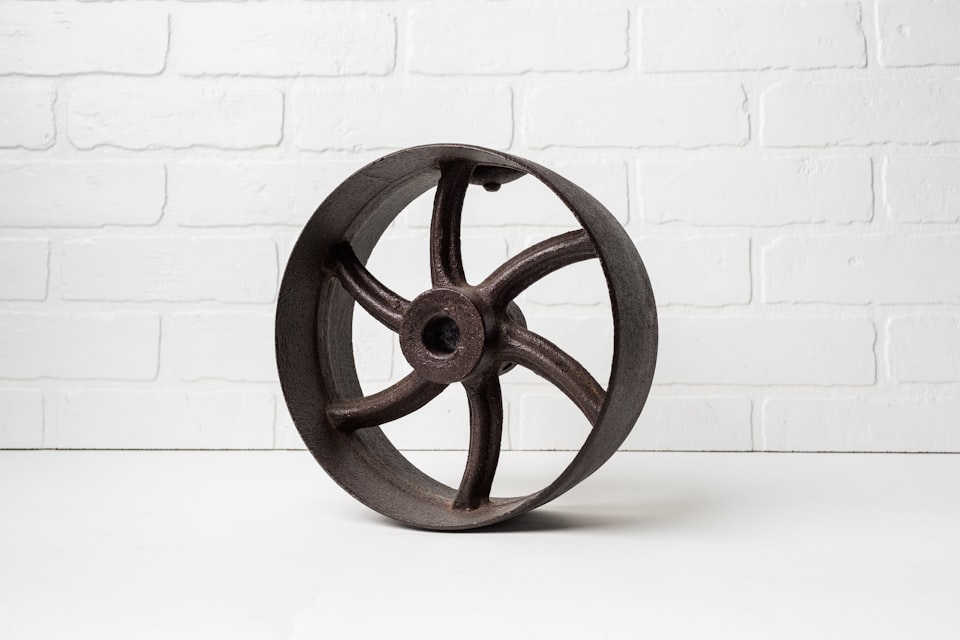The Craftsman Flywheel

The first time I heard the concept of a flywheel was from Jim Collins in his book Good to Great, and then I devoured his monograph on the same subject a few years later.
But recently it seems like all my friends are catching on.
We need to lay some ground work so that we can fully grok the power and importance of flywheels in your business.
A flywheel is a machine that aligns nicely with the craftsman mindset that Cal Newport talks about in his book So Good They Can’t Ignore You, and that I expanded on in my book Craftsman Creative.
Cal compares two different approaches, or mindsets, to creative work. First is the more common passion mindset. This is where you do creative work when you feel like it, or when the muse inspires you. You only do the work that you feel compelled to do, or the work you’re passionate about.
While that may work for some, it’s a faulty belief that it’s the best way to build a sustainable creative business. There is plenty of work you don’t feel compelled to do or are passionate about. For you that may be marketing, or accounting, or audience building.
So, instead you have the craftsman mindset - an outcome focused approach to creative work. Where you first decide what you want out of all of the work you’re about to do, and then you do whatever it takes to achieve that outcome.
As I wrote about in my last book, there is a difference between how artists and business owners run their businesses. You can call the artist approach the “passion mindset” and the business owner approach the “craftsman mindset”.
So how does this all tie into this chapter, which is supposed to be about flywheels? It’s because when you look at what I’ll call the “craftsman flywheel”, you’ll instantly understand whether you have a flywheel, which direction it’s spinning, and what causes lead to the desired outcomes you have for your business.
This chapter is about clarity.
The most-often asked question I hear from creative business owners is “how do you do it?” They don’t yet understand the system that generates the outcome of a successful, profitable creative business.
So let’s look at the mindset piece first, and then we’ll build the flywheel that will ultimately become the system that makes your business work throughout the rest of this book.
THE CRAFTSMAN FLYWHEEL
Imagine a circle. At the top you have MINDSET, on the right you have POTENTIAL, at the bottom you have ACTION, and on the left you have RESULTS.
Now if you’re reading this book because you feel stuck, frustrated, or hopeless, it’s because your flywheel is either non existent, or not moving in either direction.
If you feel like you’re working as hard as you can and still seeing no results, if every year in business is a 50/50 chance that it will be worse than last year, and if you feel like you’re going backwards, then your flywheel is going in reverse, or counter-clockwise.
Specifically, you have a limiting mindset, which makes you focus on the lack of or lackluster results, which makes you uninspired to take any action, which limits your potential, and reinforces your limiting mindset.
That’s a vicious cycle. One that will take some effort and time to slow down, stop, and reverse. But that’s what you need to do.
The goal for all of us creative business owners is to get this craftsman mindset flywheel going in the right direction, or clockwise around this circle.
We want an empowering mindset, that helps us see the massive potential we have through our business, which inspires massive action, which inevitably leads to the results we’re after, which reinforces our empowering mindset.
Whether forward or reverse, the flywheel picks up speed and momentum with each and every turn. The first step is to understand which direction our flywheel is turning. Then to make sure that it’s turning in the right direction. Then to increase the speed by increasing the frequency with which we go around that circle.
How do you turn a flywheel? With effort.
For this specific flywheel, it requires diligence in maintaining an empowering mindset, even if the results aren’t there to reinforce it. Mindset is the start of the flywheel, and then as you go around the circle the results you get reinforce the mindset you started with. This is why we discussed faith in the earlier chapter. Faith is belief coupled with action.
If you’re struggling to improve or shift your mindset, then look back at any time you achieved something, big or small. You got a degree. Your first client. Your first five-figure project. You won an award. Someone reached out to you to partner with you.
Focus on the results you’ve achieved in the past and you’ll feel the limiting mindset of fear dissipate.
Then start to think about what is possible. Don’t try and build the next Netflix or Apple. Find a goal that is within your reach with some focused effort and massive action. As an example - 20% growth is a great goal.
Then take action. What that looks like for you is different than anyone else reading this book. Maybe it’s reaching out to a dozen potential partners. Maybe it’s cold-calling for clients. Creating a new offer. Executing at a higher level. Promoting and marketing yourself within your industry. Whatever action looks like for you, do it at a higher standard than you have been up to this point.
Action leads to results. If you’re not getting the results you want, don’t give up - change the action.
When you start to see the results, celebrate them! This helps you foster the empowering mindset that turns the flywheel again and again and again.
As I’ve said before and will say many many more times - and credit to Tony Robbins who share this maxim with me - “Success is 80% mindset, only 20% strategy and skills”. This craftsman flywheel is the mindset piece that leads to the results you’re after, but you have to embody it and foster it every single day until, like a physical flywheel, the momentum you’ve built up keeps the flywheel in motion with less and less effort on your part. That’s the result we’re all after when it comes to our mindset.
TAKE ACTION 1. Focus for a few minutes on all of the positive results you’ve achieved in your career and with your business so far. Write them down, list them out, and really look at them so that you feel the sense of accomplishment. 2. List out at least 10 ideas that you could work on. Projects, clients, partners, offers, and marketing campaigns. Do it right after step one so you’re in an empowered mindset when you do this step. 3. Pick one of those ideas, then list out every action step you can think of. 4. Take action before you finish the exercise. Make a call, write a post promoting your business, send an email with the new offer to a previous customer or potential partner.
Action leads to results. So use this process to decide what action to take, and then do it.

Sponsored By Lulu.com
The team at Lulu has been an incredible partner since I released my last book, Craftsman Creative - How Five-Figure Creators Can Build Six-Figure Businesses.
We've partnered on this next book, Blockbuster, to share the ins and outs, the behind the scenes of writing and publishing a book in public.
To learn more about how Lulu can help you get your book out into the world, visit lulu.com by clicking the button below:
NEXT CHAPTER
PREVIOUS CHAPTER



Member discussion